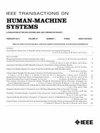Correlations Between Biomechanical Variables and Subjective Measures of Satisfaction While Using a Passive Upper-Limb Exoskeleton for Overhead Tasks in the Field
IF 4.4
3区 计算机科学
Q2 COMPUTER SCIENCE, ARTIFICIAL INTELLIGENCE
引用次数: 0
Abstract
This article proposes a novel evaluation approach on wearing passive upper-limb exoskeletons for overhead tasks in real-world automotive manufacturing lines. We determined that wearing exoskeletons reduced the biomechanical efforts of workers measured by joint kinematics and electromyography as well as the estimated shoulder joint reaction forces and torques derived from simulation. These quantitatively measured variables were statistically associated with subjective measures collected through satisfaction questionnaires. We specifically found that participants increased the shoulder flexion and abduction angles as well as the shoulder range of motion while wearing exoskeletons. Participants also reduced muscle activities, joint torques for shoulder flexion, and reaction forces exerted on the shoulder joints while wearing exoskeletons. Interestingly, our analysis also found that the increased shoulder movement while wearing the device was negatively associated with the satisfaction level. This indicates that although the assistance provided by the device allows users to perform a wider range of arm lifting movements, the deviation from their original movement with the device may lead to decreases in satisfaction levels. This integrative approach using biomechanics and ergonomics suggests that we can potentially predict the subjective scale of satisfaction based on biomechanical variables and preliminarily evaluate the usability and comfort while wearing exoskeletons in real-world settings.在野外使用被动式上肢外骨骼进行头顶任务时,生物力学变量与主观满意度测量之间的相关性
本文提出了一种新的评估方法,用于实际汽车生产线上架空任务中被动式上肢外骨骼的佩戴。我们确定,通过关节运动学和肌电图测量,以及模拟得出的估计肩关节反作用力和扭矩,佩戴外骨骼减少了工人的生物力学努力。这些定量测量的变量在统计上与通过满意度问卷收集的主观测量相关联。我们特别发现,佩戴外骨骼的参与者增加了肩膀的屈曲和外展角度,以及肩膀的活动范围。参与者还减少了肌肉活动,肩部屈曲的关节扭矩,以及佩戴外骨骼时施加在肩关节上的反作用力。有趣的是,我们的分析还发现,佩戴该设备时肩部运动的增加与满意度呈负相关。这表明,尽管该设备提供的辅助允许用户进行更大范围的手臂提升运动,但偏离他们使用该设备的原始运动可能导致满意度下降。这种结合生物力学和人体工程学的方法表明,我们可以根据生物力学变量预测主观满意度,并初步评估在现实环境中佩戴外骨骼时的可用性和舒适性。
本文章由计算机程序翻译,如有差异,请以英文原文为准。
求助全文
约1分钟内获得全文
求助全文
来源期刊

IEEE Transactions on Human-Machine Systems
COMPUTER SCIENCE, ARTIFICIAL INTELLIGENCE-COMPUTER SCIENCE, CYBERNETICS
CiteScore
7.10
自引率
11.10%
发文量
136
期刊介绍:
The scope of the IEEE Transactions on Human-Machine Systems includes the fields of human machine systems. It covers human systems and human organizational interactions including cognitive ergonomics, system test and evaluation, and human information processing concerns in systems and organizations.
 求助内容:
求助内容: 应助结果提醒方式:
应助结果提醒方式:


